Comparative Study on the Diffusion of Thermal Discharge from Coastal Power Plants in Different Geographical Environments
Abstract
1. Introduction
2. Materials and Methods
2.1. Study Areas
2.2. In Situ Data
2.3. Methods
2.4. Model Validation
3. Results
3.1. Tidal Current Characteristics
3.1.1. Ningde Nuclear Power Plant
3.1.2. Kemen Power Plant
3.2. Thermal Diffusion Range
3.2.1. Thermal Diffusion Range in the Sea Area of the Ningde Nuclear Power Plant
3.2.2. Thermal Diffusion Range in the Sea Area of the Kemen Power Plant
4. Discussion
4.1. Diffusion Direction of the Water Temperature
4.2. Influence Range of the Temperature Rise
4.3. Range of High-Temperature Rise Envelopes
5. Conclusions
Author Contributions
Funding
Institutional Review Board Statement
Informed Consent Statement
Data Availability Statement
Acknowledgments
Conflicts of Interest
References
- Verones, F.; Hanafiah, M.; Pfister, S.; Huijbregts, M.; Pelletier, G.; Koehler, A. Characterization factors for thermal pollution in freshwater aquatic environments. J. Environ. Sci. Technol. 2010, 44, 9364–9369. [Google Scholar] [CrossRef] [PubMed]
- Liu, Y.; Chen, L.; Qiao, Y.; Yang, Y.; Cao, L. The maximum temperature limit of thermal discharge from typical northern coastal npp. J. Mar. Environ. Sci. 2016, 35, 827–830. [Google Scholar] [CrossRef]
- Dai, Y.; Qiu, J.; Pan, L.; Peng, X.; Lin, B.; Huang, Y.; Chen, X. Effect of temperature rise and free residual chlorine on growth of subcordiform flat algae in simulated power plant. J. Mar. Sci. 2018, 42, 134–140. [Google Scholar] [CrossRef]
- Widya, R.; Cahyaningsih, S.; Wulan, D.R.; Sembiring, T. Water quality assessment around a coal-fired power plant in southern coast of Java, Indonesia. Reg. Stud. Mar. Sci. 2019, 25, 100463. [Google Scholar] [CrossRef]
- Lin, Z.; Zhan, H. Effects of thermal effluent on fish eggs and larvae in waters near Daya Bay nuclear plant. J. Trop. Oceanogr. 2000, 19, 44–51. [Google Scholar] [CrossRef]
- Zhang, H.; Zhao, Y.; Yang, H.; Chen, B.; Ding, J.; Dai, G.; Du, P. Study on the temperature rise characteristics and influence effects of thermal discharge from coastal power plant in Xiangshan Bay. J. Shanghai Ocean Univ. 2013, 22, 274–281. [Google Scholar]
- Fu, Q.; Zhu, L.; Shen, A.; Li, D. Survey and comparison of seasonal influences of thermal discharge from coastal power plant on zooplankton community. J. Ocean Univ. China 2015, 45, 25–33. [Google Scholar] [CrossRef]
- Li, X.; Li, B.; Sun, X. Effects of a coastal power plant thermal discharge on phytoplankton community structure in Zhanjiang Bay, China. Mar. Pollut. Bull. 2014, 1, 210–217. [Google Scholar] [CrossRef]
- Dong, Y.; Zuo, L.; Ma, W.; Chen, Z.; Cui, L.; Lu, S. Phytoplankton community organization and succession by sea warming: A case study in thermal discharge area of the northern coastal seawater of China. Mar. Pollut. Bull. 2021, 169, 112538. [Google Scholar] [CrossRef]
- Zhang, J.; Wang, Y.; Ottmann, D.; Cao, P.; Yang, J.; Yu, J.; Lv, Z. Seasonal variability of phytoplankton community response to thermal discharge from nuclear power plant in temperate coastal area. Environ. Pollut. 2023, 318, 120898. [Google Scholar] [CrossRef] [PubMed]
- Zhang, J.; Jia, H.; Feng, W. Analysis of characteristics of thermal discharge of the Chaozhou Power Plant. Trans. Oceanol. Limnol. 2013, 2, 37–43. [Google Scholar]
- Jia, H.; Xie, J.; Zhang, J. Distribution of warm discharge water and cooling effect of drainage engineering at the Zhuhai Power Station. Coast. Eng. 2014, 3, 1–9. [Google Scholar] [CrossRef]
- Zhu, Z.; Hu, Z.; Zhang, Y.; Chi, W.; Liu, J.; Bian, S.; Xiong, C. Numerical simulation and observations of vertical non-uniform of water temperature in the Meizhou Bay influenced by warm water discharge. Adv. Mar. Sci. 2014, 2, 230–238. [Google Scholar] [CrossRef]
- Wang, L. Three-dimensional numerical simulation for thermal discharge of offshore power plant. Guangdong Water Resour. Hydropower 2016, 6, 1–5. [Google Scholar]
- Zeng, Z.; Luo, Y.; Chen, Z.; Tang, J.; Wang, Y.; Chen, C. Impact assessment of thermal discharge from the Kemen Power Plant based on field observation and numerical simulation. J. Coast. Res. Spec. Issue 2020, 104, 351–361. [Google Scholar] [CrossRef]
- Gaeta, M.G.; Samaras, A.G.; Archetti, R. Numerical investigation of thermal discharge to coastal areas: A case study in South Italy. Environ. Modell. Softw. 2019, 124, 104596. [Google Scholar] [CrossRef]
- Chen, Z.; Zeng, Z.; Chen, C.; Tang, J. Study on the planar distribution and vertical variation of temperature rise by the influence of thermal discharge in coastal power plant-a case on Luoyuan Bay Kemen Power Plant. Mar. Environ. Sci. 2023, 42, 111–121. [Google Scholar] [CrossRef]
- Zhang, X.; Shi, H.; Zhan, C.; Zhu, J.; Wang, Q.; Li, G. Numerical simulation calculation of thermal discharge water diffusion in coastal nuclear power plants. Atmosphere 2023, 14, 1371. [Google Scholar] [CrossRef]
- Huang, X.; Chen, X.; Peng, X.; Zhang, R.; Qian, X.; Tang, J. The research progress of the impact of thermal discharge from coastal power plants on marine environment. Mar. Environ. Sci. 2014, 33, 972–976. [Google Scholar] [CrossRef]
- He, Q.; Ren, M.; Cai, Y.; Ye, H.; Huang, X. Research progress on the impact of thermal discharge from coastal power plants on the ecological environment. Ocean Dev. Manag. 2012, 29, 84–88. [Google Scholar]
- Lin, j.; Yan, Q.; Chen, B.; Du, P. Ecological impact of thermal discharge from coastal power plants on plankton biomass in Xiangshan Bay. J. Shanghai Ocean Univ. 2015, 24, 894–905. [Google Scholar]
- Zheng, L.; Zhang, A.; Qu, L.; Yuan, Y. Evaluation of the environmental effect of the thermal discharged water from Qingdao coastal power plant in Jiaozhou Bay. Trans. Oceanol. Limnol. 2012, 2, 137–141. [Google Scholar] [CrossRef]
- Li, B.; Zhang, C.; Sun, S. The effects of thermal discharge from Zhanjiang power plant on marine ecologic environment. Environ. Sci. Technol. 2012, 35, 78–84. [Google Scholar]
- Cheng, Y.; Hao, Q. Effects of topography on diffusion of thermal discharge in power plant. Procedia Environ. Sci. 2011, 11, 618–623. [Google Scholar] [CrossRef]
- Lin, J.; Zou, X.; Huang, F.; Yao, Y. Quantitative estimation of sea surface temperature increases resulting from the thermal discharge of coastal power plants in China. Mar. Pollut. Bull. 2021, 164, 112020. [Google Scholar] [CrossRef] [PubMed]
- Mei, L.; Cai, X.; Lai, M.; Zhou, X.; Zhuang, Y. Retrospective evaluation research on marine ecological effects of warm water drainage from Mawan Power Plant in Shenzhen. Environ. Eng. 2012, S2, 349–351. [Google Scholar]
- Huang, G.; Huang, B.; Qiu, J. A study of the affection of different drainage velocity on water temperature field. Jilin Water Resour. 2014, 8, 12–16. [Google Scholar] [CrossRef]
- Tu, X.; Gao, S.; Chen, R.; Wu, T. Research on movement and diffusion regularities of cooling water from power plant at estuary area under control of tide. Chin. J. Hydrodyn. 2014, 29, 157–165. [Google Scholar]
- Jia, H.; Zheng, S.; Xie, J.; Ying, X.; Zhang, C. Influence of geographic setting on thermal discharge from coastal power plants. Mar. Pollut. Bull. 2016, 111, 106–114. [Google Scholar] [CrossRef] [PubMed]
- Casulli, V.; Cattani, E. Stability, accuracy and efficiency of a semi-implicit method for three-dimensional shallow water flow. Comput. Math. Appl. 1994, 27, 99–112. [Google Scholar] [CrossRef]
- Casulli, V.; Zanolli, P. A three-dimensional semi-implicit algorithm for environmental flows on unstructured grids. In Proceedings of Numerical Methods for Fluid Dynamics VI, Arcachon, France, 6–10 July 1998; ICFD: Oxford, UK, 1998. [Google Scholar]
- Casulli, V.; Cheng, R.T. Semi-implicit finite difference methods for three-dimensional shallow water flow. Int. J. Numer. Methods Fluids 2010, 15, 629–648. [Google Scholar] [CrossRef]
- Tang, J.; Wen, S.; Chen, C. Numerical simulation of two-dimensional tidal current model for Haitan Strait. J. Appl. Oceanogr. 2006, 25, 533–540. [Google Scholar] [CrossRef]

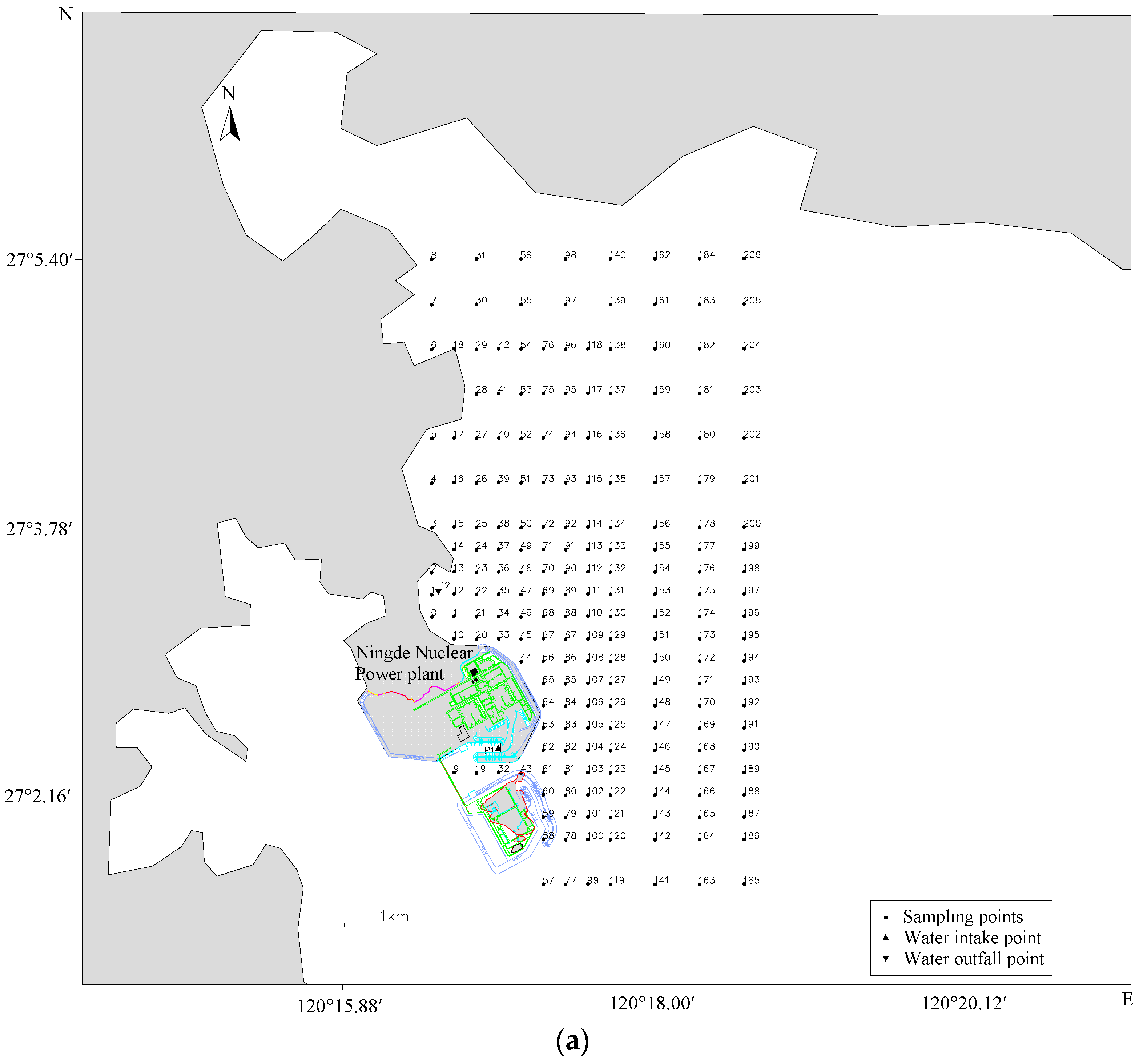


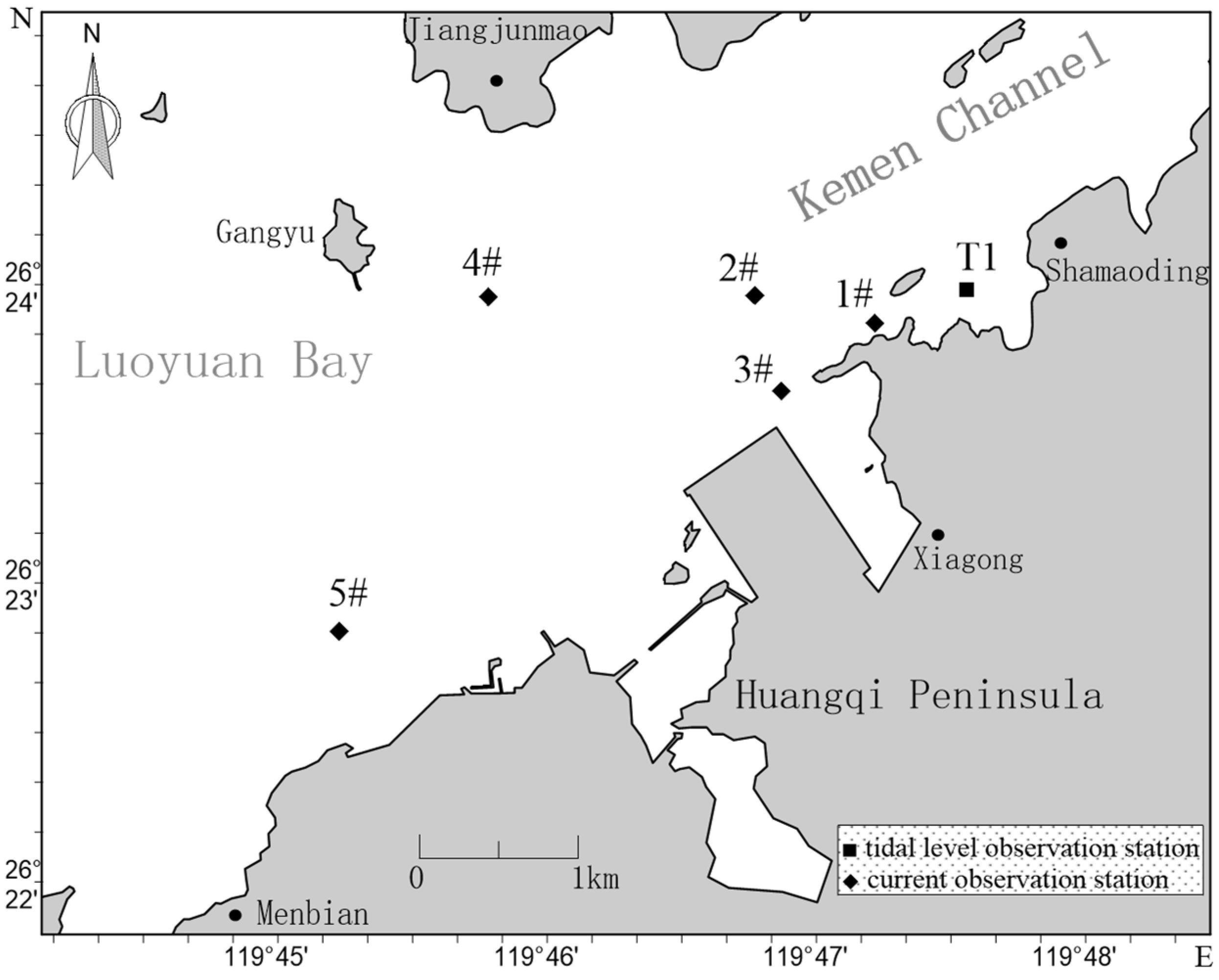


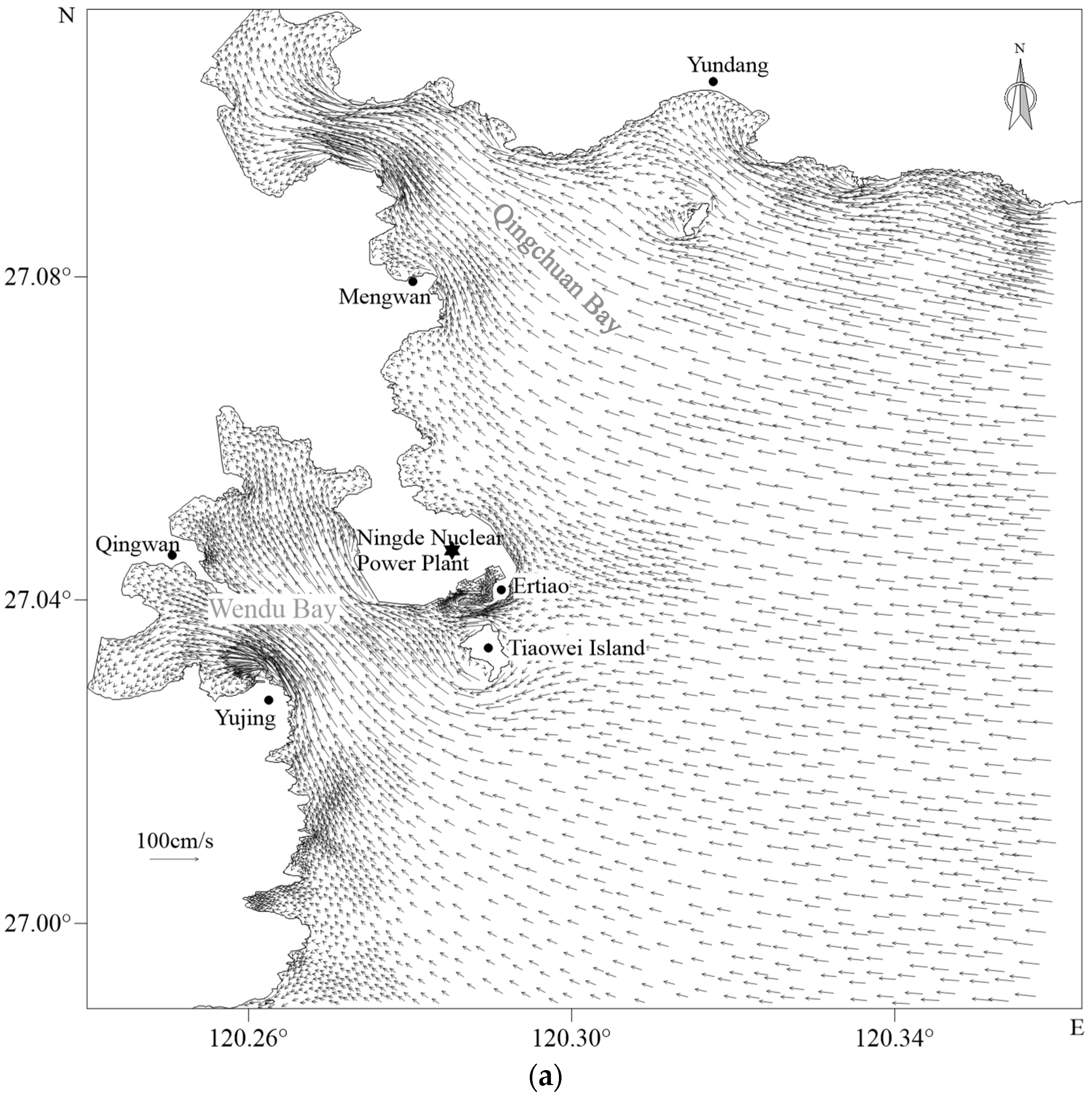
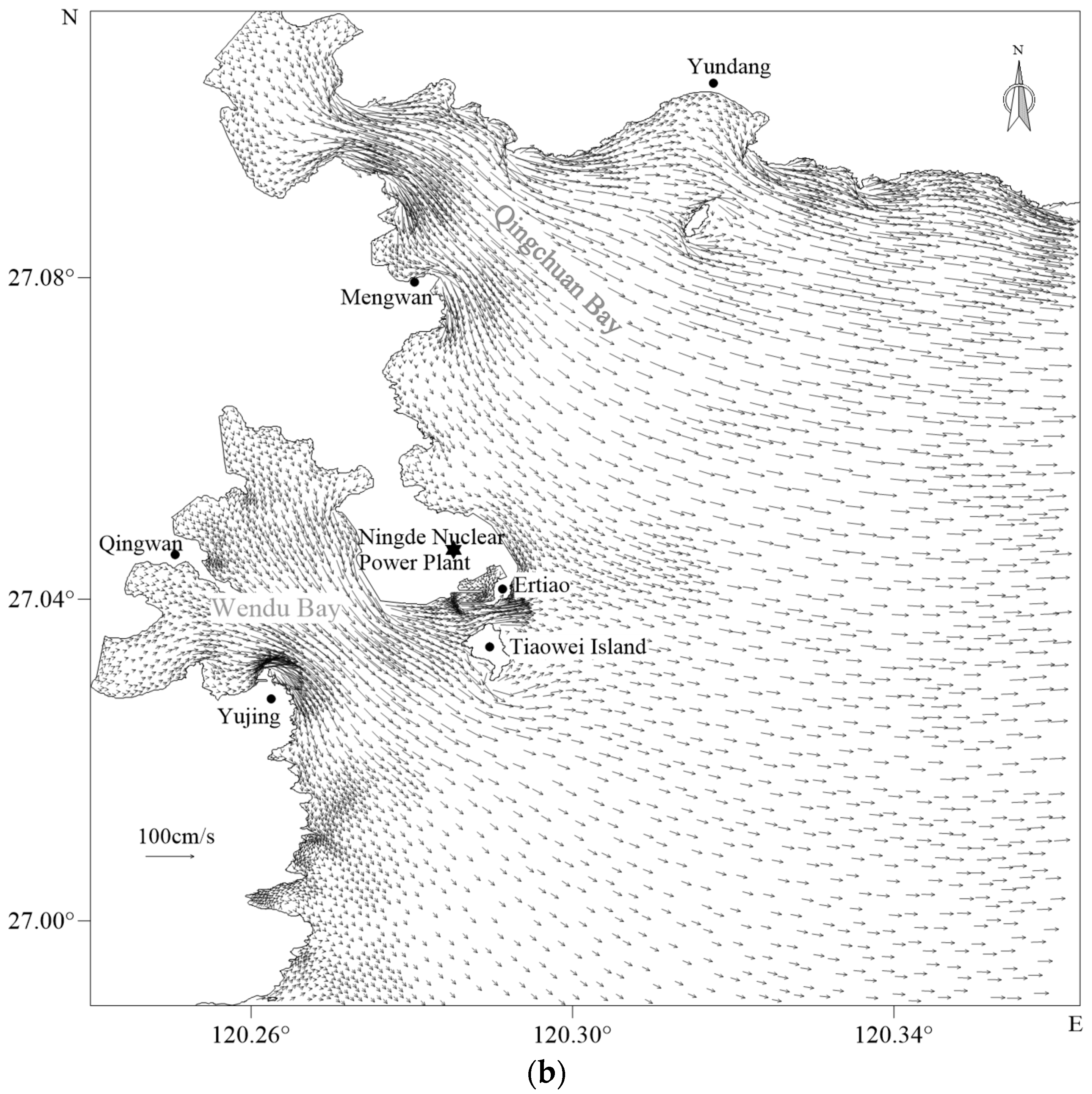
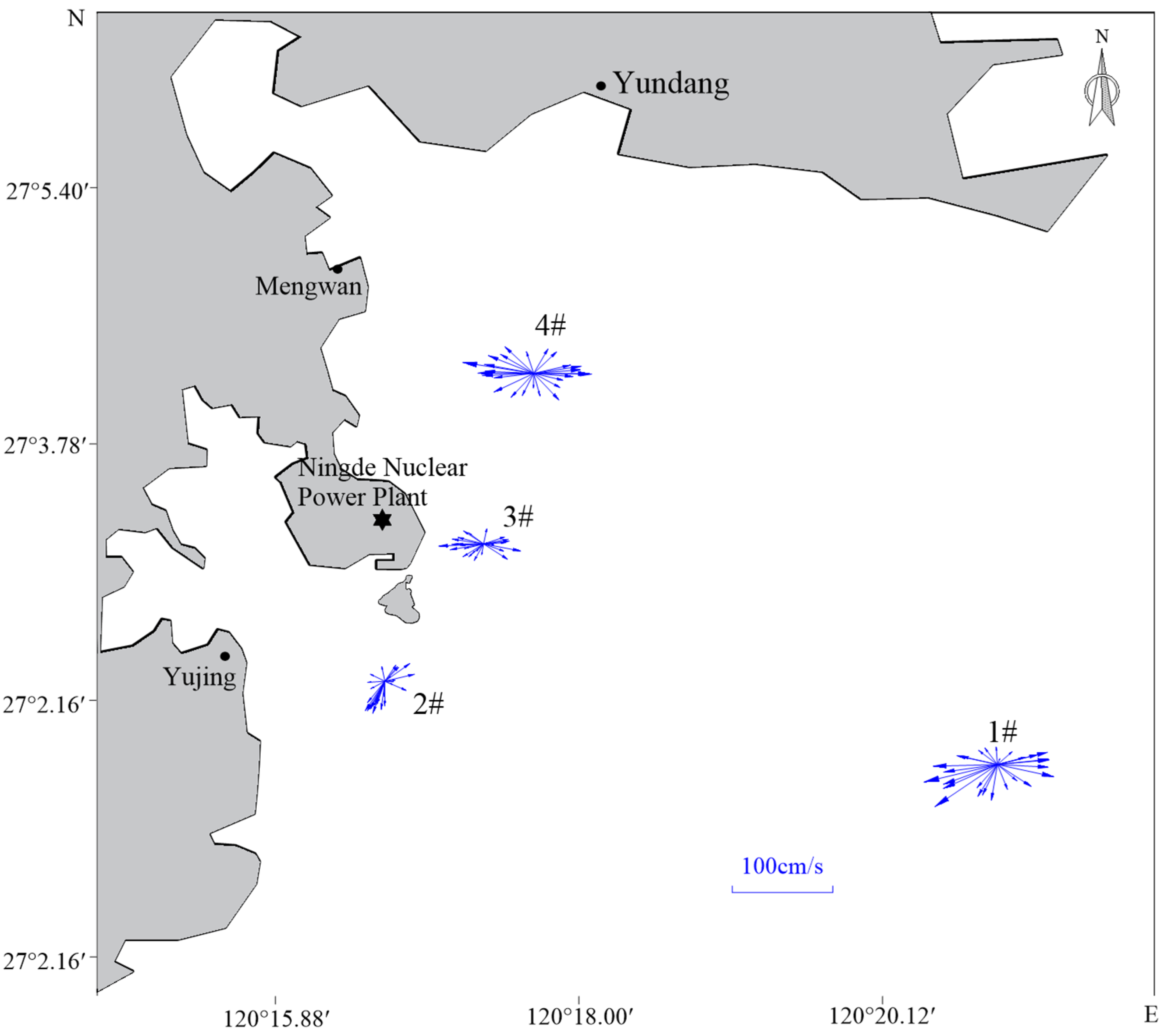
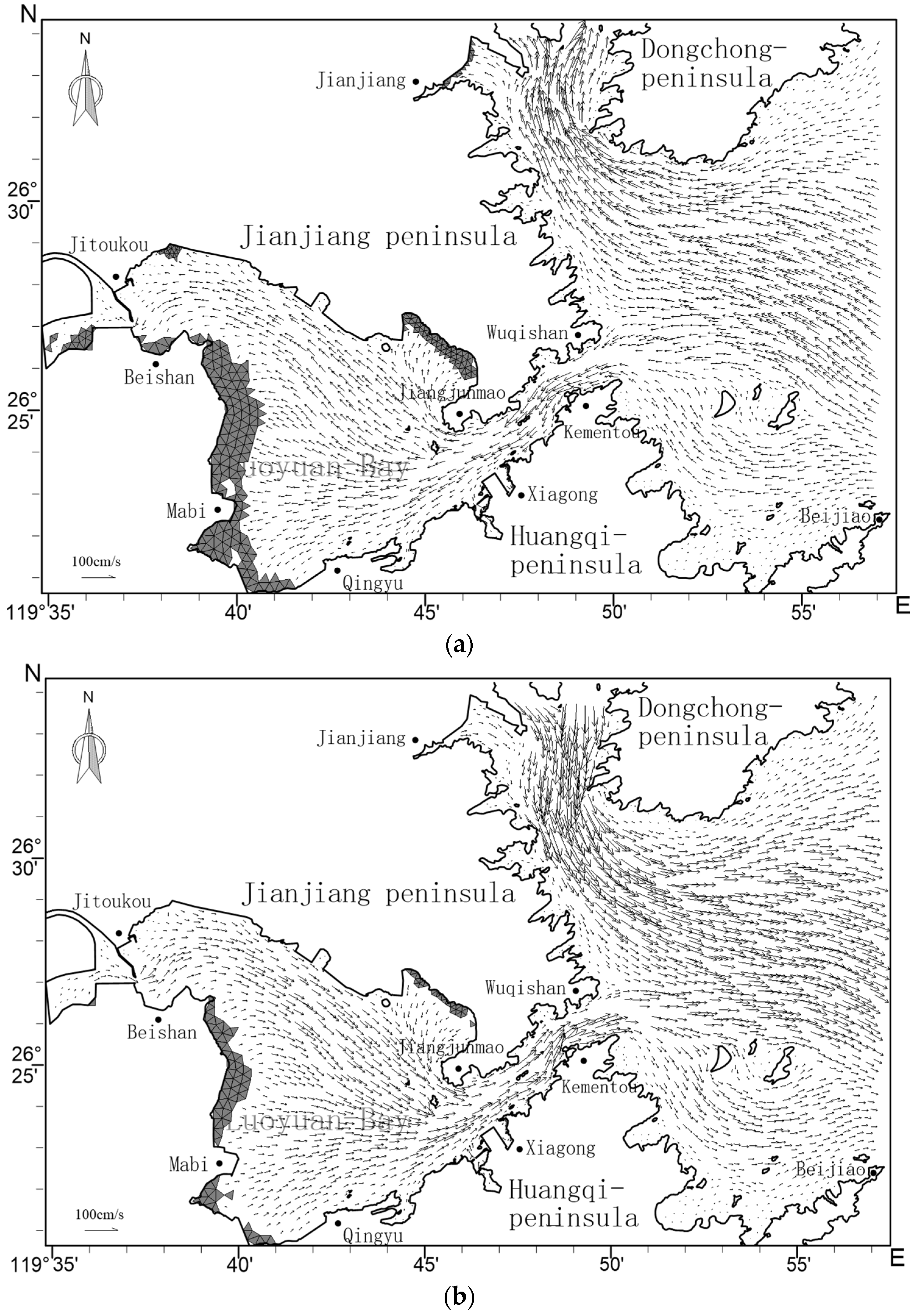
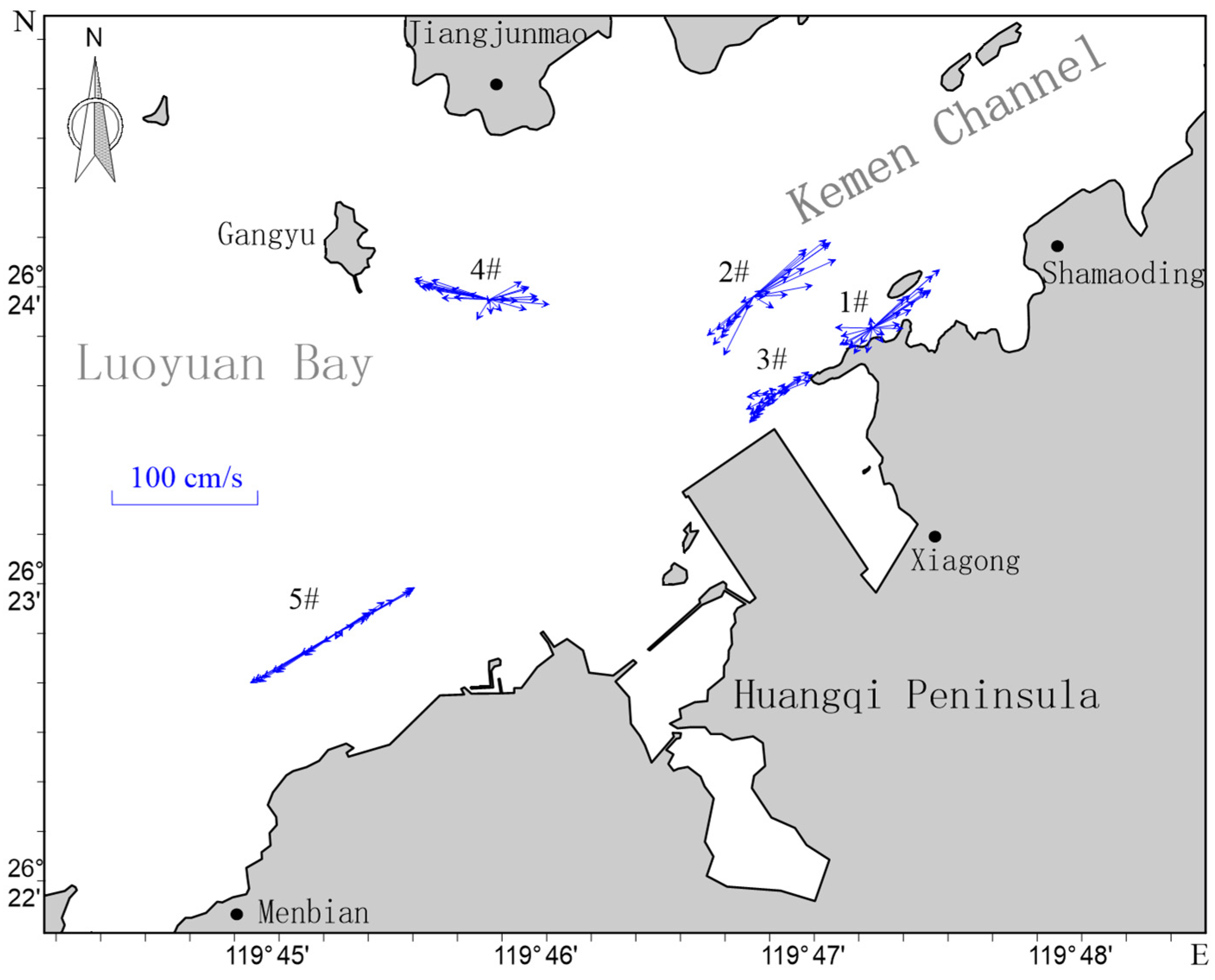

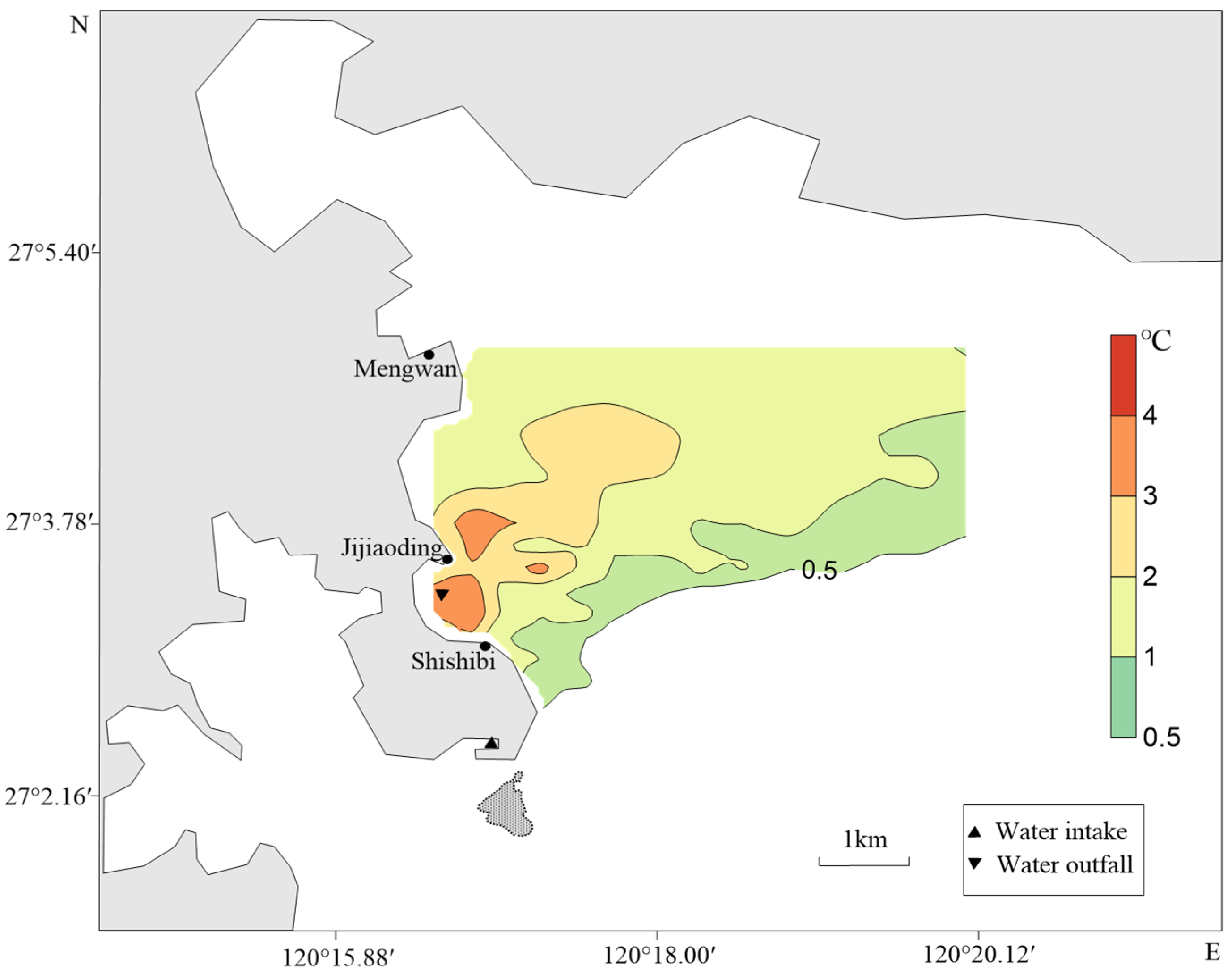
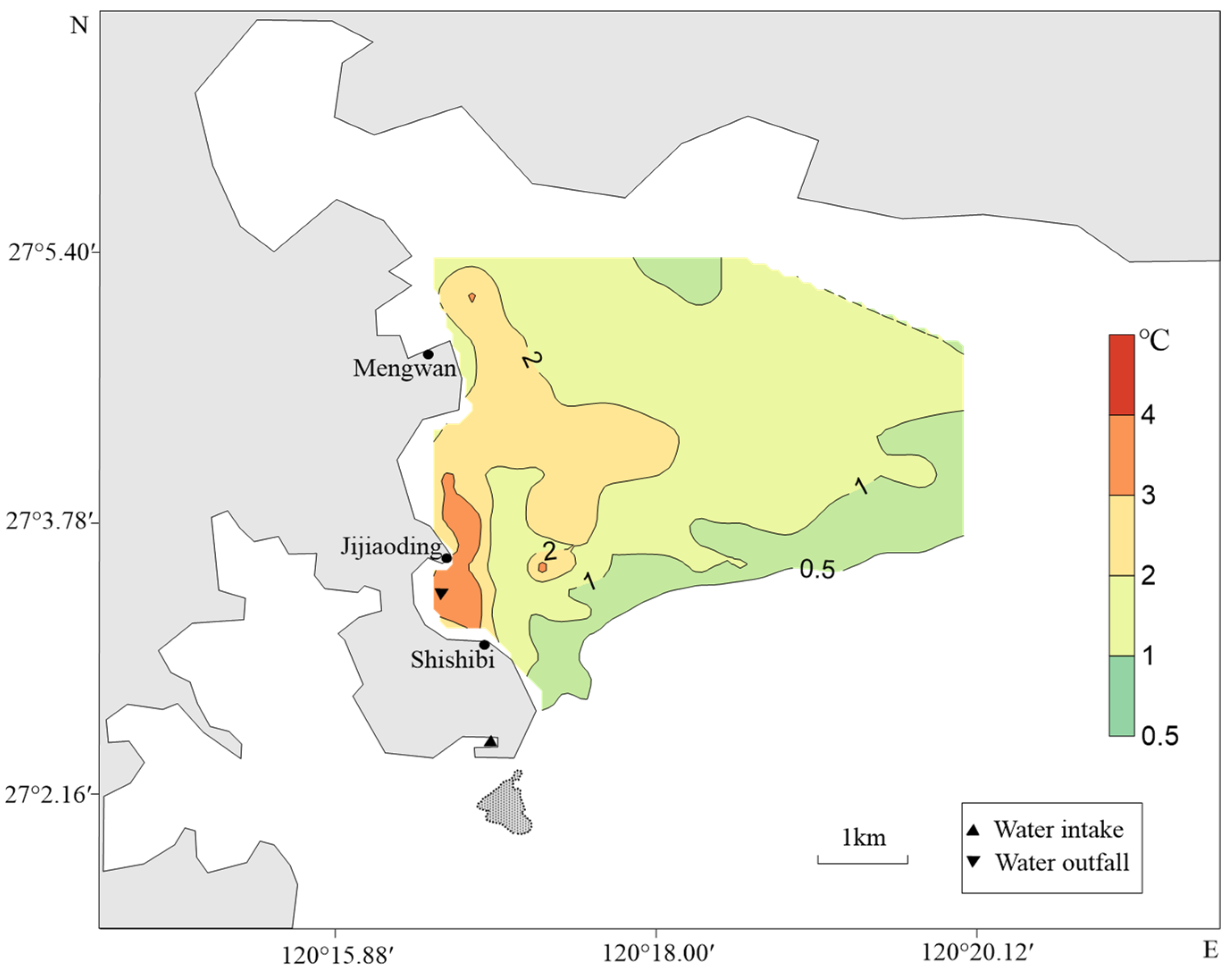
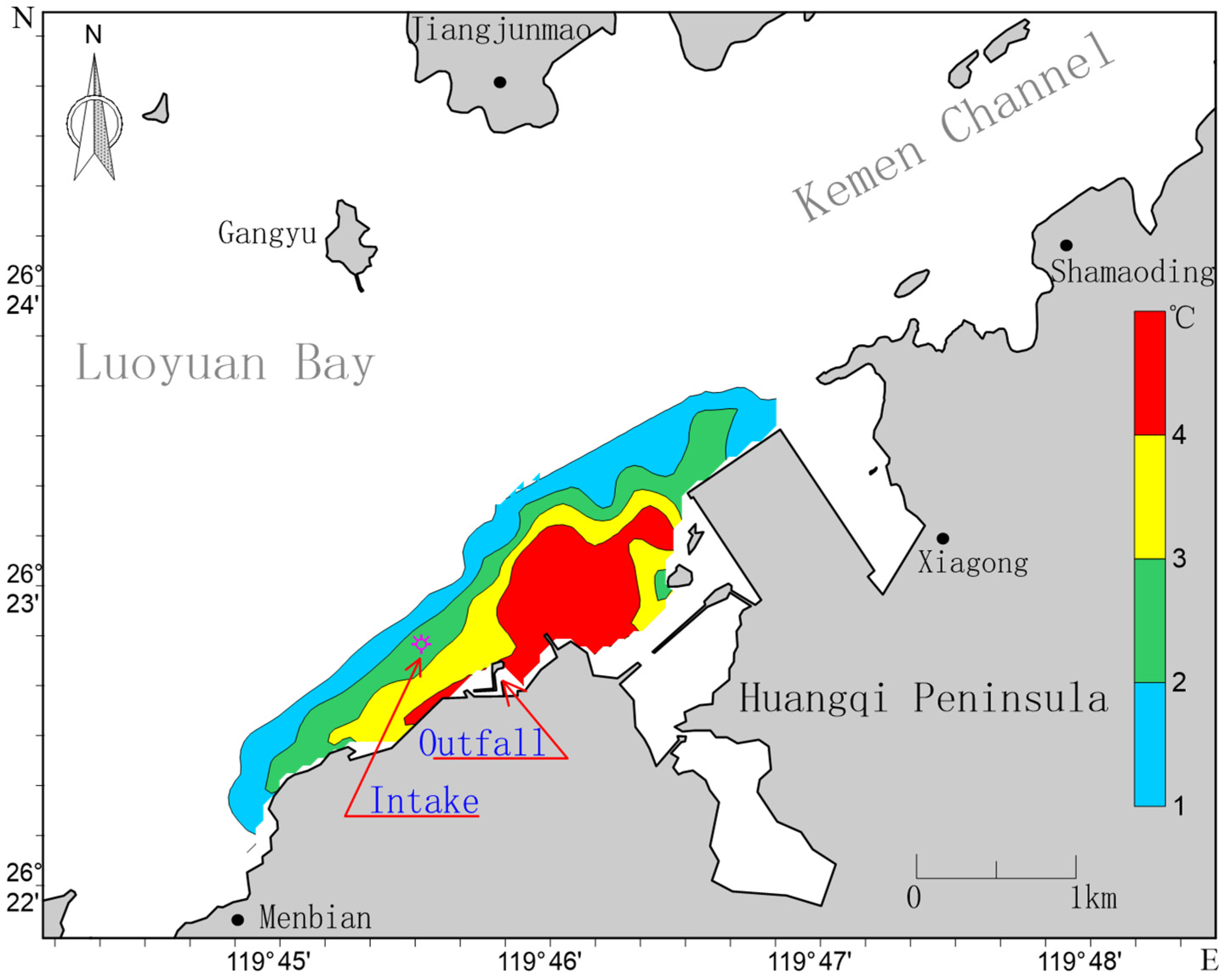
| Temperature Rise | ||||
|---|---|---|---|---|
| >0.5 °C | >1 °C | >2 °C | >3 °C | |
| envelope area (km2) | 21.80 | 17.50 | 5.50 | 1.30 |
| Temperature Rise | |||||
|---|---|---|---|---|---|
| Tidal Time | >1 °C | >2 °C | >3 °C | >4 °C | |
| envelope area (km2) | ebb strength | 1.52 | 0.78 | 0.34 | 0.25 |
| ebb slack | 1.42 | 0.83 | 0.49 | 0.29 | |
| flood strength | 1.47 | 0.93 | 0.49 | 0.20 | |
| whole tide | 2.99 | 2.16 | 1.32 | 0.65 | |
| Characteristic Items | |||||
|---|---|---|---|---|---|
| Direction of Temperature Diffusion | Maximum Temperature Rise | Variation of Temperature Rise with Distance | Average Value in the High Temperature Rise Area (≥3 °C) | High Temperature Rise Zone | |
| Ningde Nuclear Power Plant (open sea) | Alongshore and offshore and a tendency for diffusion towards the offshore | <4 °C | As the distance increases, the temperature rise decreases | Smaller | The dominant flood tidal current side |
| Kemen Power Plant (well-sheltered bay) | Mainly alongshore | >4 °C | As the distance increases, the temperature rise decreases | Larger | The dominant ebb tidal current side |
Disclaimer/Publisher’s Note: The statements, opinions and data contained in all publications are solely those of the individual author(s) and contributor(s) and not of MDPI and/or the editor(s). MDPI and/or the editor(s) disclaim responsibility for any injury to people or property resulting from any ideas, methods, instructions or products referred to in the content. |
© 2025 by the authors. Licensee MDPI, Basel, Switzerland. This article is an open access article distributed under the terms and conditions of the Creative Commons Attribution (CC BY) license (https://creativecommons.org/licenses/by/4.0/).
Share and Cite
Chen, Z.; Wang, Z.; Zeng, Z.; Tang, J. Comparative Study on the Diffusion of Thermal Discharge from Coastal Power Plants in Different Geographical Environments. J. Mar. Sci. Eng. 2025, 13, 383. https://doi.org/10.3390/jmse13020383
Chen Z, Wang Z, Zeng Z, Tang J. Comparative Study on the Diffusion of Thermal Discharge from Coastal Power Plants in Different Geographical Environments. Journal of Marine Science and Engineering. 2025; 13(2):383. https://doi.org/10.3390/jmse13020383
Chicago/Turabian StyleChen, Zhijie, Ziqing Wang, Zhi Zeng, and Junjian Tang. 2025. "Comparative Study on the Diffusion of Thermal Discharge from Coastal Power Plants in Different Geographical Environments" Journal of Marine Science and Engineering 13, no. 2: 383. https://doi.org/10.3390/jmse13020383
APA StyleChen, Z., Wang, Z., Zeng, Z., & Tang, J. (2025). Comparative Study on the Diffusion of Thermal Discharge from Coastal Power Plants in Different Geographical Environments. Journal of Marine Science and Engineering, 13(2), 383. https://doi.org/10.3390/jmse13020383






